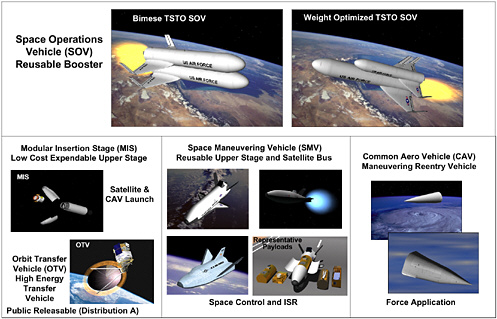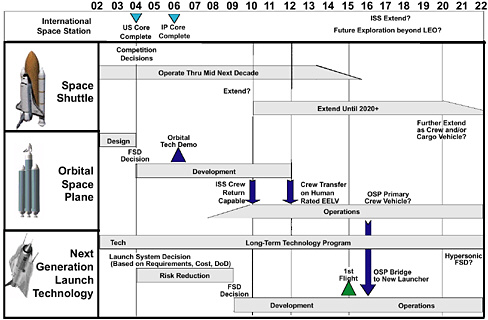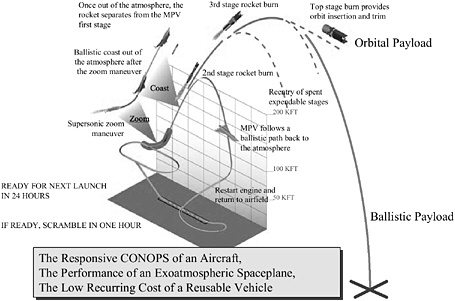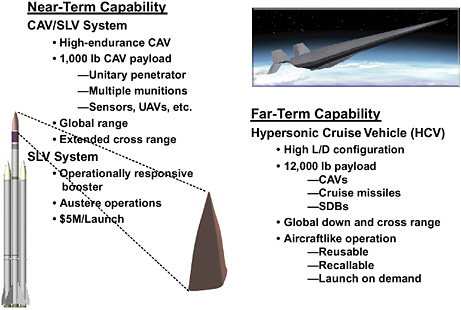D
National Aerospace Initiative Access-to-Space Programs
SPACE ACCESS TECHNOLOGY PROGRAMS
Next-Generation Launch Technology
NASA’s Next-Generation Launch Technology (NGLT) program has as an objective the development and demonstration of high leverage and cross-cutting technologies to enable safe, reliable, and affordable space launch systems capabilities. Currently funded at over $500 million per year, the effort is directed to shuttle life extension and expendable launch upgrades in the near term, exploration launch in the medium term, and new launch capabilities in the far term.
The NGLT program seeks to develop and mature innovative technologies with new research in the areas of propulsion, structures, vehicle systems, and ground and flight operations. The program is currently pursuing development of a reusable liquid oxygen/liquid kerosene rocket booster engine; hypersonic, air-breathing propulsion and airframe systems; crosscutting launch vehicle system technologies intended to support a broad variety of launch and flight vehicle architectures; and analysis efforts to guide program investment.
In 2004, the program will decide whether to proceed with a next-generation launch vehicle risk-mitigation phase, which includes research and testing of large-scale tanks, structures, and engines. The following list is a representative list of the NASA NGLT programs:
-
X-43A
-
X-43C
-
Revolutionary turbine accelerator
-
Rocket-based combined cycle
Air Force Research Laboratory Programs
The Air Force Research Laboratory (AFRL) is the technology development arm of the Air Force for hypersonics, space access, and spaceborne systems. Current NAI-specific and -related funding within AFRL is over $200 million, with space access receiving about $100 million of support. NAI plus-ups could add $25 million to the Space Access numbers for FY 2004. AFRL programs support upgrades to current expendable launch systems and new capabilities in rapid
launch, reusable launch vehicles, rapid turnaround operations, and so on, for support of the future mission needs of the Air Force commands.
The activities in Space Access pursued by AFRL include propulsion, thermal protection systems, aerothermodynamics of high-speed vehicles, integrated vehicle health management systems, simulation-based research and development, and others. The following is a representative list of AFRL technology programs:
-
Integrated high-payoff rocket propulsion technology (IHPRPT)
-
Integrated powerhead demonstrators
-
Reusable access to space-Technology (RAS-T)
-
X-43B
-
Force Application and Launch from CONUS (FALCON)
-
Hydrocarbon scramjet development (one effort of HyTech)
SPACE ACCESS DEMONSTRATION PROGRAMS
There are significant NAI demonstration programs within DARPA.
Responsive Access, Small Cargo, Affordable Launch
Responsive Access, Small Cargo, Affordable Launch (RASCAL) is a three-phase demonstration program to provide a path toward a revolution in rapid access to space. RASCAL consists of a reusable aircraft as the launch platform and a two-stage expendable rocket vehicle for accelerating a 165-lb payload to orbital velocity. The RASCAL aircraft utilizes standard military jet engines augmented by mass injection precompressor cooling (MIPCC), which allows operation at higher velocities and altitudes. Figure D-1 illustrates the system.
While still in the atmosphere, the RASCAL aircraft accelerates to a high velocity and begins a steep climb. With MIPCC, the aircraft accelerates while climbing until the engines are shut down at 100,000 feet and then coasts to an altitude of 200,000 feet, where the expendable rockets are released. The aircraft then reenters the atmosphere and returns to its base of operations. An operational system would be capable of rapid turnaround.
Force Application and Launch from CONUS
DARPA and the Air Force are jointly sponsoring the FALCON program to develop technologies and demonstrate capabilities that will enable Prompt Global Strike from the continental United States. The small launch vehicle (SLV) that is part of FALCON (Figure D-2) will serve a twofold function in that it will also provide a low-cost responsive capability for launching satellites up to the 2,000-lb class into Sun-synchronous orbit.
For the access-to-space application, the SLV must be at least an order of magnitude more responsive than existing satellite launch systems and must have a low launch cost. The program will pursue development of an innovative concept possessing these attributes for flight demonstration in the 2007 time frame. The program will also seek to develop a unique CONOPS that will support and enable both the responsiveness and low-cost system objectives.
FUTURE SPACE ACCESS PROGRAMS WITHIN THE NATIONAL AEROSPACE INITIATIVE
Air Force
Operationally Responsive Spacelift
Currently, in the analysis-of-alternatives phase, the ORS program will develop a capability to launch, maneuver, service, and retrieve space payloads. The key element is responsiveness, with the long-term goal of hours vs. today’s experience of weeks to months. The military spaceplane system architecture shown in Figure D-3 is a current concept of an operational system.
The access-to-space elements of the system are the space operations vehicle (SOV), the modular insertion stage (MIS), and the space maneuver vehicle (SMV). The SOV is believed to be the most difficult and will require a phased demonstration approach to mitigate risk in areas such as fast turn propulsion, thermal protection systems, metallic tank and insulation, power and actuation systems, and ground operations.
Small, Low-Cost Launch Vehicle
A possible outgrowth of the joint Air Force/DARPA FALCON program is a small, low-cost, expendable launch vehicle capable of rapid launch and available substantially before the military space plane (MSP).

FIGURE D-3 Military spaceplane system architecture. SOURCE: Koozin, 2003.
X-42
The X-42 is envisioned to be a flying testbed for validating selected technologies developed since the late 1980s. In addition to being an environment simulator for airframe and flight subsystems technologies, NAI advertises that the X-42 will be used to evaluate improved technologies and approaches for fighterlike operability in a military space plane-type system. If designed properly, it can also be used as a payload integration testbed enabling flight testing of next-generation air-breathing propulsion technologies. As envisioned today, X-42 would be scalable to the second stage of a two-stage-to-orbit space plane. Scalability ensures that component technologies will be developed and flight-tested in environments relevant to the operational end system.
Upgrades to Current Expendable Launch Vehicles
Replacements for the Russian RD-180 booster engine and the Centaur and Inertial Upper Stage are under consideration.
National Aeronautics and Space Administration
Expendable Launch Vehicles
Upgrade of an existing expendable launch vehicle to carry the crew exploration vehicle into low Earth orbit for crew transfer to the International Space Station is a possibility. The crew exploration vehicle is currently being studied for possible implementation in this decade, first as a crew rescue vehicle and soon thereafter as a crew transfer vehicle. Like its predecessor, the orbital space plane, it is not anticipated that the crew exploration vehicle will fall under the umbrella of NAI.
Development of a heavy-lift (130 metric tons), expendable launch system for both crewed and uncrewed exploration of the solar system has gained support among some at NASA.
Reusable Launch Vehicle
Given appropriate funding and emphasis, the NGLT program could lead to a rocket-based reusable launch vehicle in the next decade as a replacement for the space shuttle, providing both uncrewed and crewed access to space. An overview of NASA’s space transportation plan is shown in Figure D-4.

FIGURE D-4 Integrated Space Transportation Plan before the Presidential Vision announcement of January 14, 2004. SOURCE: Rogacki, 2003.
REFERENCES
Unpublished
Koozin, W. 2003. ORS Operations Concept. Briefing by Walt Koozin, Air Force Space Command, to the Committee on the National Aerospace Initiative. October 7.
Morrish, A. 2003. DARPA Programs for the National Aerospace Initiative Objective. Briefing by Art Morrish, DARPA, to the Committee on the National Aerospace Initiative. August 5.
Rogacki, J. 2003. The National Aerospace Initiative–A Synergistic Partnership between NASA and DoD. Briefing by John “Row” Rogacki, NASA, to the Committee on the National Aerospace Initiative. August 5.








